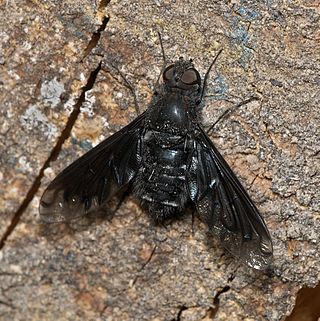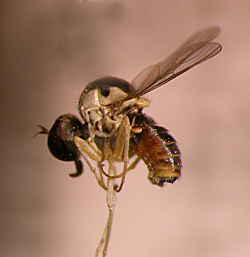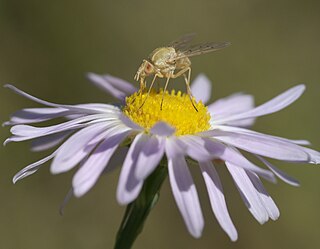
The Bombyliidae are a family of flies, commonly known as bee flies. Some are colloquially known as bomber flies. Adults generally feed on nectar and pollen, some being important pollinators. Larvae are mostly parasitoids of other insects.

Anthrax is a genus of bombyliid flies, commonly known as "bee-flies" due to their resemblance to bees. Most are dull black flies, and are usually small to medium in size, 4–20 millimetres (0.2–0.8 in), and many species have striking wing patterns.

Mythicomyiidae, commonly called mythicomyiids, are very tiny flies (0.5–5.0 mm) found throughout most parts of the world, especially desert and semi-desert regions, except the highest altitudes and latitudes. They are not as common in the tropics, but genera such as Cephalodromia and Platypygus are known from these regions. Many of these "microbombyliids" have a humpbacked thorax and lack the dense vestiture common in the Bombyliidae. Mythicomyiids have until recently not had much attention in the literature. Their small size has caused them to be missed when collecting. Yellow pan trapping and fine-mesh netting in Malaise and aerial sweep nets has resulted in a number of undescribed species from many parts of the world. A high diversity of both genera and species exists for this family in Africa, especially northern and southern portions. About 350 species are known. Hundreds more await description.

Villa is a genus of flies belonging to the bee-fly family (Bombyliidae). They range in size from 5 to 17 millimetres, and have typically rounded heads. The males of some species have a brilliant mat of silvery patagial scales. About 270 Villa species are found on all continents except Antarctica.
Neal Luit Evenhuis is an American entomologist. He works at the Bishop Museum in Hawaii. Evenhuis has described over 500 species of insects since 1976, and is known both for his research and peculiar binomial names.
Anthrax nigriventris is a species of bee fly in the family Bombyliidae. It is found in the southwestern United States, Mexico, and Cuba.

Poecilognathus is a North and South American genus of bee flies in the family Bombyliidae. There are about 13 described species in Poecilognathus.

Brachyanax is a genus of bee fly in the subfamily Anthracinae. It was circumscribed by Neal Evenhuis in 1981. Thirteen species are recognized, and they are found in Asia and Australasia.

Chrysanthrax is a genus of bee flies in the family Bombyliidae, found in North and South America.
Lepidanthrax eremicus is a species of bee fly in the family Bombyliidae. It is known from California.
Ogcodocera analis is a species of bee fly in the family Bombyliidae. It is found in Mexico, Arizona, and Texas.
Villa chromolepida is a species of bee fly in the family Bombyliidae.
Anthrax cascadensis is a species of bee fly in the family Bombyliidae. It is found in the western United States, north into British Columbia, Canada.
Anthrax pauper is a species of bee fly in the family Bombyliidae. It is found in the eastern United States from Texas north to Ontario, Canada.
Villa harveyi is a species of bee fly in the family Bombyliidae.

Dipalta serpentina is a species of bee fly in the family Bombyliidae. It is widespread in North America from British Columbia, Canada south and east through most of the United States to Florida, Mexico, Cuba, Guatemala, and Honduras. It is a parasitoid of antlion species such as Myrmeleon immaculatus.

Phthiria is a genus of bee flies in the family Bombyliidae. There are over 60 described species in the genus, found in Eurasia, Africa, and South America. Related species from North America have been moved to other genera.
Chrysanthrax adumbrata is a species of bee fly in the family Bombyliidae. It is found in California and Baja California Norte.
Chrysanthrax scitulus is a species of bee fly in the family Bombyliidae. It is known from California and Nevada.

Phthiriini is a tribe of bee flies in the family Bombyliidae. There are about 6 genera and more than 90 described species in Phthiriini, found worldwide.









